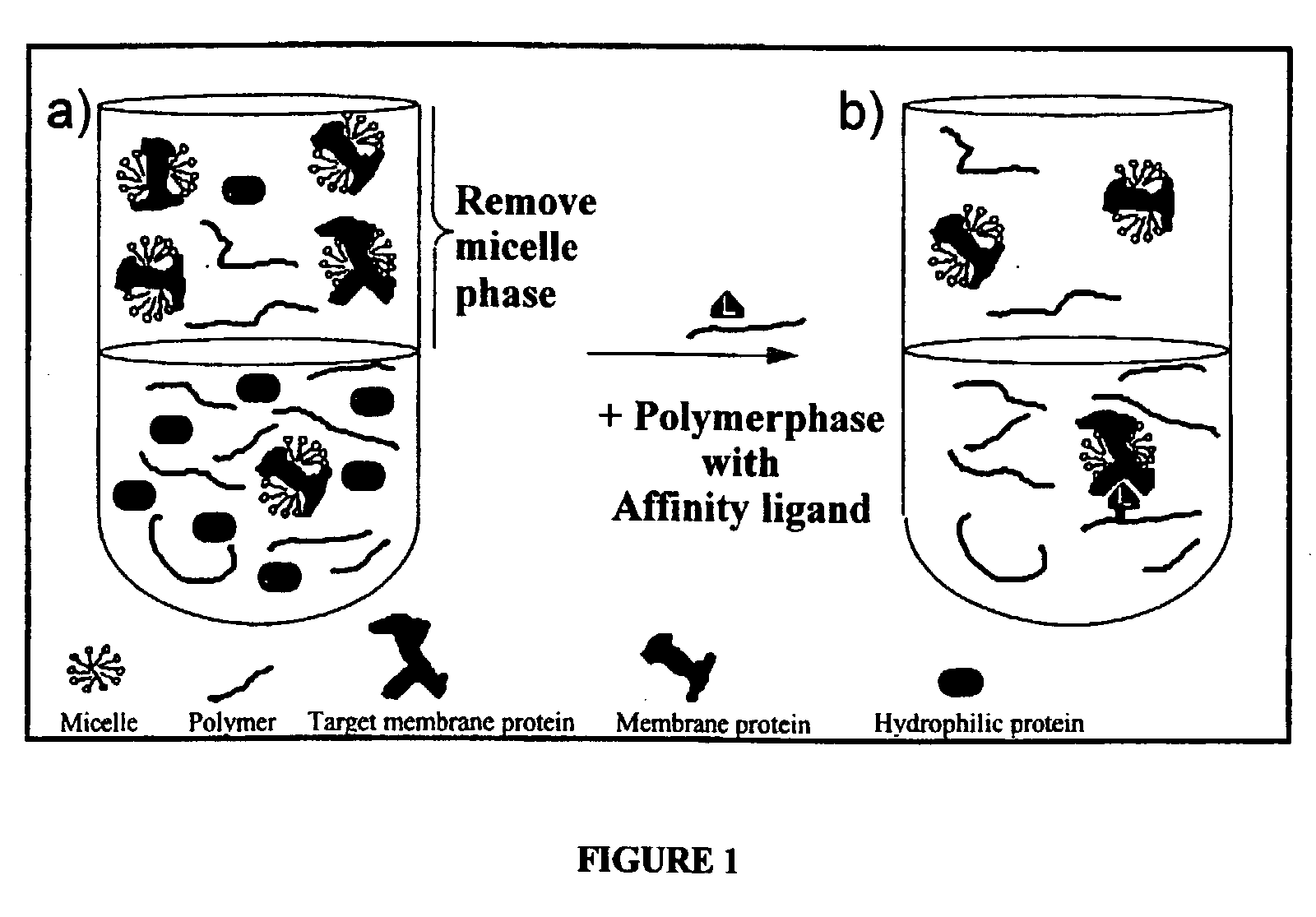Method for the isolation of hydrophobic proteins
- Summary
- Abstract
- Description
- Claims
- Application Information
AI Technical Summary
Benefits of technology
Problems solved by technology
Method used
Image
Examples
example 2
Effect of pH on the Partitioning of CytBO3
[0079] System composition: 0.071 mmole*kg.sup.-1 PEG-IDA chelated copper ions, 6.5% (w / w) total PEG concentration (i.e. 5.2% (w / w) PEG 40000+1.3% (w / w) PEG 40000-IDACu(II) with DS of 0.22 mole IDA per mole PEG), 13.0% (w / w) Triton X-100, 10 mmol* kg.sup.-1 phosphate-borate buffer, pH 5.5, 6.0, 6.5, 7.0, 7.5, 8.0, 8.5, 9.0, ca. 0.02% (w / w) CytBO3, temperature 3-4.degree. C. (phase volume ratio 1.14). K>1 is equivalent to a preferred protein partitioning into the polymer phase (the PEG phase is the upper phase).
[0080] Results and discussion: The affinity partitioning of CytBO3 to the polymer phase increased with pH. At low pH the membrane protein partitioned strongly into the micelle phase, while the partitioning towards the polymer phase was strongly increased at increasing pH and leveled off around pH 7.5. The pH dependence can be explained by the deprotonation of the imidazole group of the histidine, which is completed at pH 7.5 (35,36). Th...
example 3
Effect of NaClO.sub.4 Concentration on the Partitioning of CytBO3
[0081] System composition: 4.9% (w / w) C.sub.12EO.sub.5, 3.8% (w / w) total dextran concentration (i.e. dextran T500 (3.8 or 3.04%(w / w))+dextran T150-IDACu(II) with DS of 115 mole IDA per mole dextran (0 or 0.76% (w / w), respectively), 10 mmol*kg.sup.-1 phosphate-borate buffer, pH 9.0, ca. 0.02% (w / w) CytBO3, temperature 3-4.degree. C. (phase volume ratio 0.48). The concentration of NaClO.sub.4 was varied between o to 100 mmole*kg.sup.-1. K<1 is equivalent to a preferred protein partitioning (dextran phase is the lower phase).
[0082] Results and discussion: The effect on the partitioning of CytBO3 by dextran-IDA-Cu(II) was very low in systems with no addition of salt, K-values only shifted from 10 to 4 in a C.sub.12EO.sub.5 / dextran system. Thus, the dextran could not pull the membrane protein sufficiently well into the polymer phase. But we also noted that the dextran-IDA-Cu(II) seemed to partition almost evenly between the...
example 4
Effect of an Ionic Detergent (SDS) on the Affinity Partitioning of CytBO3
[0083] System composition: 5.2% (w / w) C.sub.12EO.sub.5, 6.6% (w / w) total dextran concentration (i.e. dextran T500 (3.8 or 3.04%(w / w))+dextran T150-IDACu(II) with DS of 115 mole IDA per mole dextran (0 or 0.76% (w / w), respectively), 10 mmol*kg.sup.-1 phosphate-borate buffer, pH 9.0, ca. 0.02% (w / w) CytBO3, temperature 3-4.degree. C. (phase volume ratio 0.27). The SDS concentration varied from 0 to 0.25% (w / w). K<1 is equivalent to a preferred protein partitioning (the dextran phase is the lower phase).
[0084] Results and discussion: Protein partitioning can be shifted by addition of charged phase components to the system. For example, addition of ionic surfactants to the system, such as SDS or DTAB, creates a weakly charged mixed micelle that attracts oppositely charged proteins and repel similar charged proteins to the opposite phase (26), the effect is larger for hydrophilic proteins than for membrane proteins ...
PUM
| Property | Measurement | Unit |
|---|---|---|
| Temperature | aaaaa | aaaaa |
| Temperature | aaaaa | aaaaa |
| Temperature | aaaaa | aaaaa |
Abstract
Description
Claims
Application Information
 Login to View More
Login to View More - R&D
- Intellectual Property
- Life Sciences
- Materials
- Tech Scout
- Unparalleled Data Quality
- Higher Quality Content
- 60% Fewer Hallucinations
Browse by: Latest US Patents, China's latest patents, Technical Efficacy Thesaurus, Application Domain, Technology Topic, Popular Technical Reports.
© 2025 PatSnap. All rights reserved.Legal|Privacy policy|Modern Slavery Act Transparency Statement|Sitemap|About US| Contact US: help@patsnap.com

